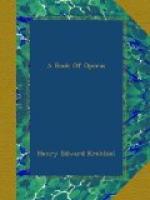Verdi followed his friend’s advice, and the khedive accepted the terms. At first the opera people in Cairo thought they wanted only the score which carried with it the right of performance, but soon they concluded that they wanted also the presence of the composer, and made him, in vain, munificent offers of money, distinctions, and titles. His real reason for not going to prepare the opera and direct the first performance was a dread of the voyage. To a friend he wrote that he feared that if he went to Cairo they would make a mummy of him. Under the terms of the agreement the khedive sent him 50,000 francs at once, and deposited the balance of 50,000 francs in a bank, to be paid over to the composer on delivery of the score.
The story of “Aida” came from Mariette Bey, who was then director of the Egyptian Museum at Boulak. Auguste Edouard Mariette was a Frenchman who, while an attache of the Louvre, in 1850, had gone on a scientific expedition to Egypt for the French government and had discovered the temple of Serapis at Memphis. It was an “enormous structure of granite and alabaster, containing within its enclosure the sarcophagi of the bulls of Apis, from the nineteenth dynasty to the time of the Roman supremacy.” After his return to Paris, he was appointed in 1855 assistant conservator of the Egyptian Museum in the Louvre, and after some further years of service, he went to Egypt again, where he received the title of Bey and an appointment as director of the museum at Boulak. Bayard Taylor visited him in 1851 and 1874, and wrote an account of his explorations and the marvellous collection of antiquities which he had in his care.
Mariette wrote the plot of “Aida,” which was sent to Verdi, and at once excited his liveliest interest. Camille du Locle, who had had a hand in making the books of “Les Vepres Siciliennes” and “Don Carlos” (and who is also the librettist of Reyer’s “Salammbo"), went to Verdi’s home in Italy, and under the eye of the composer wrote out the drama in French prose. It was he who gave the world the information that the idea of the double scene in the last act was conceived by Verdi, who, he says, “took a large share in the work.” The drama, thus completed, was translated into Italian verse by Antonio Ghislanzoni, who, at the time, was editor of the Gazetta Musicale, a journal published in Milan. In his early life Ghislanzoni was a barytone singer. He was a devoted friend and admirer of Verdi’s, to whom he paid a glowing tribute in his book entitled “Reminiscenze Artistiche.” He died some fifteen or sixteen years ago, and some of his last verses were translations of Tennyson’s poems.




